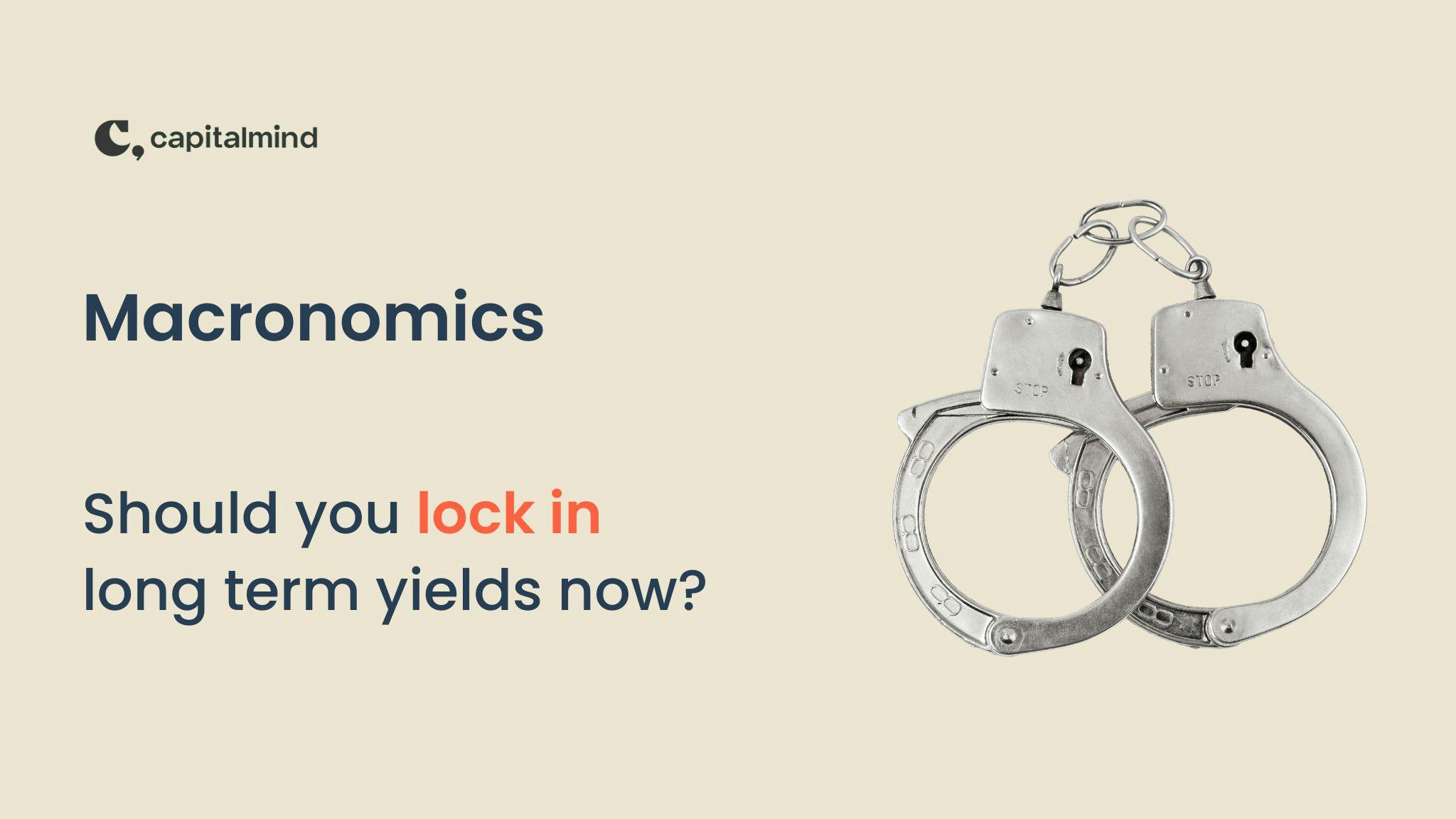(category)Fixed Income
Macronomics: Should you lock in long term yields now?Macronomics: Should you lock in long term yields now?
The RBI has raised rates by 0.5%, which seems quite expected, but it is quite positive in the way things have been put by the RBI. This is quite an interesting point for the fixed income markets, where rates are up 2% (200bps) in 5 months. Should you be locking in these "juicy" rates?
Deepak Shenoy•

Inflation comes in higher
September inflation just came in at 7.41%, much higher than the 6% upper barrier that RBI must follow. This is another reason that will make yields remain high:
Flat Yield Curve: No marks for holding long
What's really happened is that the bond market has the yield of government securities after 2 years to maturity is super-flat. There's no real premium for holding long term any more - you get 7.3% for the 2 year bond, and 7.47% in the 10 year.
Should you lock these yields forever?
7.47% is pretty good for a 10 year bond in India where inflation seems to be under relative control. However, it's not yet time to lock in longer term yields. The curve is flat, but the whole curve can go up.
Can inflation rise now? Yes, because of the rupee.
What if, for instance, the rupee depreciation to Rs. 82 to a dollar hurts us big time? The answer might be to move our trade either to rupees or at least spread across other currencies, where we have actually seen rupee appreciation.
A large part of Indian imports are denominated in USD, so if the rupee weakens against the USD, things change for the worse for us. And the INR is weakening for two reasons:
The USD is stronger against most of the large currencies in the world. A quick check on how the USD has done in just 2022, shows the INR isn't actually as bad as the Yen, the Euro, the Pound, the Korean Won, the Australian Dollar and even the Chinese Yuan. (Only Swiss Franc, Indonesian Rupiah, Singapore Dollar and Brazilian Real have done better, on only BRL has appreciated against the dollar in 2022)
So there's a "market drift" that sends the rupee down.
The second reason is that RBI seems to be giving up, in part, it's defense of the Rupee.
RBI sells $40bn, but MTM Impact is high
The RBI actually sold only about $40 billion as part of its selling operations. But at the same time, the RBI had a massive forward purchase position which they pared down as well to the tune of $27 billion.
But the greater impact to reserves has come from a mark-to-market change of whatever they hold. We'll come to that, but what's the reserve situation?
The reserves, including forwards, were $697 billion. (Last year, when we were getting lots of flows, the RBI bought a truckload of forwards to fuel the market's appetite for the rupee. This has now reduced substantially)
There are three reasons for the drop, of nearly $150 billion in the total forex reserves
- Actual selling of $67 bn ($40 bn cash, $27 bn forwards)
- Change in the rupee value of other currencies the RBI holds as foreign currency assets. We know that the dollar has appreciated against the Euro, the JPY and the Pound, and the RBI holds all three. If you hold 100 euros, the value in dollars of the euros you held has fallen from about $120 to $98 - a 20% drop, approximately.
- Drop in the valuation of bonds and gold held by the RBI. Gold itself has fallen quite substantially in dollar terms - around 6% in 2022, and nearly 17% from the peak in March. Bonds have dropped in valuation because yields abroad went up big time, which means the bonds they hold can be sold for a lower value today than in the beginning of the year. RBI held about $363 billion in foreign securities, which would have fallen around 5% to 10%, resulting in a large mark to market loss for the RBI. (Of course RBI will probably hold to maturity and not actually lose money, but this is accounting)
This drop in forex reserves concerns a lot of people, but it's not a big deal. What's going out today will come back as our equity markets have seen major outflows in the last one year, and equity money tends to flow back to countries that are more resilient in the longer term. (Read: India) What's clear now, though, is that RBI's appetite to sell more USD is just not there anymore. So any outflows in the markets will see the rupee weakening, as it quickly did between 80 and 82.
The liquidity crunch is only just beginning
What the forex reserve hit really does is compress the RBI balance sheet substantially. Excess liquidity has fallen from 800,000 cr. last year, to about 74,000 cr. this year.
The RBI balance sheet has now compressed substantially (nearly 7%) from last year. Inflation tends to lag the change in balance sheet, and the drop in balance sheet size will only impact inflation in about 6-12 months.
In fact, if you look at the RBI's operations, over a very long period, we had excess liquidity in the system. Banks were parking excess money to the tune of Rs. 800,000 cr back with the RBI. Now, as RBI's crunched down the balance sheet, banks are now borrowing money from the RBI.
The operational rate is now closer to the Repo (overnight at 5.9%).
Banks are raising rates too, for fixed deposits. In fact, the demand for money is so high that banks first went to the CD market (a wholesale money market) to raise money for 1 year at as much as 7.4%. Now, some banks are even offering deposits - longer term - at 7.5%+.
Rates are going up for the economy. And liquidity is tight. It's likely to get tighter right now.
Yields aren't exactly very low for 7% inflation
The last time inflation was 7% was in Jan 2020 or so, but at that times yields were dropping and did heavily drop after Covid. But for most of the time that inflation was 7% or more, 10 year bond yields were higher! I would say that we might go all the way to 8% or a bit higher until inflation comes under control.
So what? Shouldn't we lock in yields right now?
What have we got so far?
- RBI is still in the rate raising cycle and continues to be so.
- Inflation is still at 7%+ which is uncomfortable.
- RBI isn't selling USD to protect the INR anymore. Which means the rupee has now hit 82+
- Since we are a net importer, a drop in the rupee means our imports will cost more, leading to more inflation
- RBI's balance sheet has come down, and liquidity is tight
- Meaning: interest rates (deposit, lending) have all gone up, but it's only the beginning
- Inflation typically lags an RBI balance sheet cut by a few quarters.
- Yields have been higher when inflation was 7% (the current figure) in the past.
In all of this, it appears that there's probably a little more damage to come. The focus of bond should be around the 2-5 year time frame if you want to park money that long.
Or, if you want to play the duration game (benefit when rates fall) then perhaps the right point would to wait for lower inflation prints, and at least one RBI "pause". That might be the time to lock in longer term yields.
There's a lot happening in the bond markets worldwide. And that will affect our bond yields eventually, but not in a straightforward way just yet. The deal about Indian bonds getting into global bond indexes has been deferred till March at least, which means the foreign rescuers for our yields (in terms of passive flows) is not happening. We'll stick with the Fixed Income portfolio as it is right now.
Note: the fixed income portfolio, after a stellar run on the INVIT/REIT combination, have returned 9.7% so far in 2022. We don't expect that to be matched any further, but a 7% estimate is decent.
See also:
- Posts on the Capitalmind Fixed Income Portfolio
- In Jan 2022: We reduced Gilts and added a Floater
- Eight fixed income instruments that beat the best FD rates in India
Related Posts
Make your money work as hard as you do.
Talk to a Capitalmind Client AdvisorInvesting is not one size fits all
Learn more about our distinct investment strategies and how they fit into your portfolio.
Learn more about our portfoliosUnlock your wealth potential
Start your journey today












